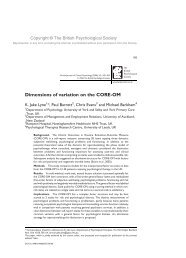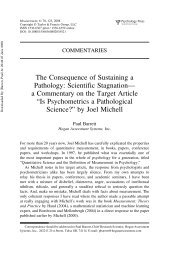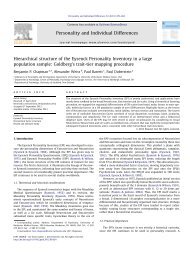Psychophysiological Methods - Paul Barrett
Psychophysiological Methods - Paul Barrett
Psychophysiological Methods - Paul Barrett
- No tags were found...
You also want an ePaper? Increase the reach of your titles
YUMPU automatically turns print PDFs into web optimized ePapers that Google loves.
Breakwell-3389-Ch-08.qxd 2/7/2006 8:49 PM Page 157applied, the properties of the signals thus generated (electrical engineering anddigital signal processing techniques) and the plethora of possible methods of analysis(both bivariate and multivariate methods of waveform analysis, periodicityanalysis, event detection, pattern recognition and clustering techniques).A simple measure such as heart rate (counted in beats per minute) seems a trivialparameter to acquire, until you ask yourself how you are going to measure theheart rate. Having found out that two electrodes placed, say, on each wrist willenable the acquisition of the information, your next problem is to work out howyou are going to extract the heart rate parameter itself: that is, how you record theelectrical signals. Assume next that you are provided with a computer-based recordingsystem set up to output a number every 10 seconds or so which indicates beatsper minute. Looking at the number, you see the heart rate is alternating between 50and 70 beats per minute. Is this acceptable? The individual being assessed is sittingquietly. Your local expert happens by and notices that the 50 Hz hardware notch filteris off. In addition, checking the earth electrode shows that very poor electricalcontact is being made between this and the individual. By improving this contactand switching the notch filter in-line, the heart rate stabilizes around 70 beats perminute.To understand what has happened requires knowledge of the expected heartrate, the properties of metallic electrodes, earthing problems, the operation of anotch filter, and the appreciation of how a heart rate monitor works. This is allbefore you begin to manipulate a single psychological variable. Note also that hereyou were dealing with a relatively large biological signal. Imagine attempting tomeasure high-frequency EEG of maybe 5 µV in amplitude with amplifiers thathave background, self-generated electronic noise of about 1 µV, and where mainsnoise can be as large as 10–20 µV. The knowledge required to ensure that the signalyou are seeing is actually biologically generated and not some property of the hardwarein use, or of bad measurement technique, is quite considerable.Unlike much purely psychological research, it is possible to generate quantitativephysiological data that are literally pure error. This is a problem in sometopographic EEG systems that provide maps of brain electrical activity computedfrom many electrodes placed upon the scalp. Most systems have automated filteringsuch that only frequencies between 0 and 40 Hz are displayed. However,if an electrode becomes detached from the scalp or its connecting wire breaks(inside the insulating plastic), this electrode will pick up large amounts of backgroundmains noise (and any other stray frequencies present in the environment).Depending upon the efficiency of the filters, this electrode position willbe seen as producing either very low-amplitude signals across the signal spectrumor high-frequency beta of moderate amplitude (where beta activity wasdefined as being from 20 Hz upwards). In this latter case, the filter does notremove all 50 Hz activity and, owing to spectral smearing (given a low samplingspeed and short segment of EEG), this gets mapped as high-frequency activity inyour EEG records. Experienced EEG technicians and researchers can invariablyPSYCHOPHYSIOLOGICAL METHODS157












